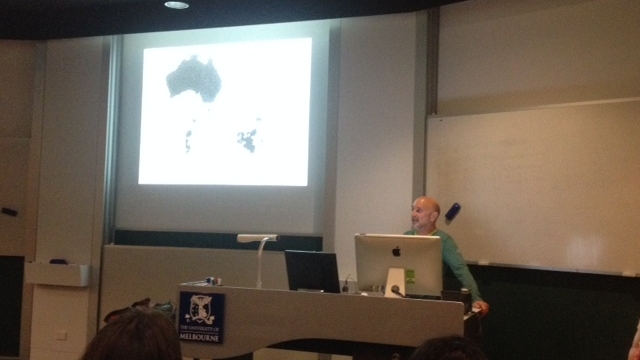From hunter-gatherers to carbon farmers?
I always enjoy a good Altman lecture and last week was no exception. Professor Jon Altman presented on From hunter-gatherers to carbon farmers in Arnhem Land as part of the University of Melbourne School of Geography Seminar Series. What did 40 years of deep experience have to say about this?
Jon set the scene using his long experience in west Arnhem Land as a backdrop. When he arrived as a fresh PhD student in 1979, collaborating with young local John Mawurndjul, Jon found a hunter-gatherer lifestyle with magpie geese, buffalo and wallaby local favourites. Hunting made up a large 64% of local economic activity. This was despite a ‘first wave of colonisation’ complete by the 1960s which had stripped people of their lands and introduced missions and settlements.

Professor Jon Altman presents on “From hunter-gatherers to carbon farmers in Arnhem Land” at the University of Melbourne
Since that time, Jon has witnessed a series of attempts to adapt to the interventions of the state and settlers. The art movement was ramping up at that time after humble beginnings in central Australia (John Mawurndjul would become a famous artist who later decorated the Musee de quai Branly in Paris). CDEP, or the Community Development Employment Projects program, also sprouted in the 1970s as a way to employ Aboriginal people in remote communities. Jon argued Aboriginal people configured these ideas in a way that made sense to them.
But in the end, the state interpreted the results as a failure. Support declined.
A new attempt at adapting, environmental management, picked up in the 1990s. While the Aboriginal estate in Australia is still largely intact, this new movement attempts to deal with threats like wild buffalo, illegal fishers and invasive weeds like mimosa pigra. In Jon’s field area, Warddeken and Djelk country have become Indigenous Protected Areas with ranger teams and management plans. Aboriginal land all over Australia now forms a huge chunk of the national conservation estate.
Carbon farming has come off the back of this wave. Aboriginal people are trying to replicate the patchy burning of pre-colonial times to prevent hot late season fires. They are also fighting fires from lightning strikes in the late dry season. In their typical way, Aboriginal people have adopted modern technology to the task such as the use of helicopters and leaf blowers.
It’s the latest effort by people to reconfigure their economy to create modern livelihoods.
In recounting this story, Jon sees great hope in payment for environmental services forming a fat wedge in a state, customary and market ‘hybrid economy’. Importantly, carbon farming is a market activity that is not state welfare. People are undertaking it on their own terms. In the case of WALFA, or the West Arnhem Land Fire Abatement project, managed by ALFA Limited, this is underlined by an early long-term deal with a large multinational, Conoco-Phillips, made while the state was still fiddling with policy settings. This relationship has proved more stable than the relationship with the state.
Of course there are still risks and challenges. Topsy-turvy wet seasons may promote grass growth all through the year and make early burns harder. Commodifying carbon may take people further away from the cultural value of burning. The emerging ‘ranger class’ with salaried jobs and cars may build economic stresses within the community.
But so far, people have reconfigured what’s on offer pretty well to align with local aspirations.
Looking to the future, however, the question will be whether this will be maintained? As with previous enterprise movements where the state removed support, will the state help or hinder in future?
Jon is worried about a ‘second wave of colonisation’ through state interference. While the state has given some enormous support for Aboriginal carbon farming to date, I tend to agree: the current signs are decidedly mixed. Let’s see.























